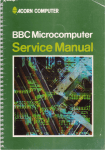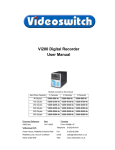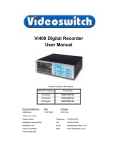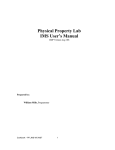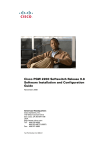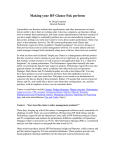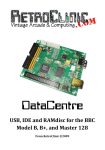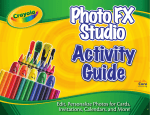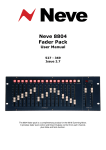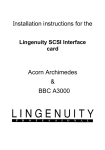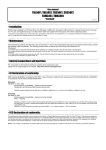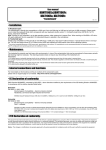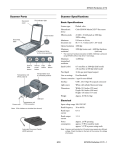Download The Domesday Device
Transcript
JOE'S JOTTINGS
THE DOMESDAY
DEVICE
Interactive video used to be slow and cumbersome, but
laser technology has changed all that
Joe Telford
y previous experience of interactive video (IV) had
come from building a VHS
video tape interface in 1981,
and writing software to
make an early Beeb fast-forward to frames
and fast-rewind to the start of passages.
This was an inaccurate and feeble attempt,
which only served to convince me that
interactive video was at that stage both
cumbersome and boring.
The chance to play with an early Acorn
IV system in 1985 amused me further, as
the only available disc seemed to be a
BBC wildlife programme about birds. The
operating system for the IV disc was
quite tedious to integrate into any sensible
language, though the few children to
whom I showed the disc felt that the way
ahead for them was Logo, interfaced to
the service ROM in the machine.
Why interactive video?
One of the activities I really enjoy is
messing with an applications based
package, to see what makes it tick. You
can imagine how I felt when news of the
Domesday System filtered through and I,
with
many
others,
watched
demonstrations, asked key questions and
tried to imagine what I could do with it.
Several months later, I can drive the beast
from its applications based software, and
from my usual languages. The question of
what to do with it is still hard to answer,
possibly because I think it's essentially a
historical archive. Also, it has gaps, and
although it won't go far enough into detail
over some things, it goes into far too much
depth over others.
The hardware: Laserdisc player and Master
day in particular and IV in general. Try to
group the uses under three headings:
educational uses, industrial uses, and
public uses. Let's see what we can come
up with, but remember to test your
application with some simple rules:
■Can it be done in another way more
economically or more effectively?
■Will using it encourage interaction between people?
■Does it matter that the information is not
first hand or up to date?
■What sort of thinking is the system
supporting? Revision? Problem solving?
Explorative?
The system itself
The Master AIV system comes as a five
part package which includes the Master
128 with 65C102 'Turbo' co-processor, an
We desperately need more experience of Acorn trackerball, a Philips RGB colour
using interactive video, so I ask readers of monitor, a Philips LV-ROM player, the
this column to write in with their sugges- Domesday discs and all connecting cables
tions for and experiences of using Domes- and manuals.
ACORN USER JULY 1987
The Master 128 Turbo is a specially
modified model, which has a wide 50way ribbon cable attached to its rear. This
is an SCSI (Small Computer Systems
Interface) cable which connects to the
LV-ROM player, and allows the Master
to take control of the LV-ROM player's
functions. But the Master can also be
used as a normal micro, running all the
packages just like a standard Master 128.
The trackerball, which looks rather like
a Marconi trackerball with an added
sticker, fits into the Master's User Port
and sits easily on the right of the
computer. It can also be lap-held so you
can use the system from a distance.
The colour monitor is a medium resolution model which is very easy on the
eyes. It has full screen control from easily
accessible knobs and has a Euroconnector
for 'proper' colour — you know, the sort
you get on TVs with not just eight
colours but the whole range of shades and
hues. This is sometimes
81
JOE'S JOTTINGS
(with two channels available), still frames
(pictures) or data for text/graphs/program
code, etc. The clever idea seems to be that
data can exist on an LV-ROM disc in the
channels allocated to sound. This means
that while the number of picture frames
can be of the order of 54,000 frames per
side, the amount of computer-readable
data can be immense, up to an incredible
350Mbytes per side (the equivalent of
about 600 ADFS floppy discs). When you
consider that most amateur users would
have difficulty in ever filling a 30Mb
Winchester hard disc with day to day
usage, the size of the LV-ROM disc
becomes astonishing. Have you noticed
though, how technology is cyclic?
The Domesday discs
Remember when you had to turn tapes
While the rest of the package is hardware, over to read the other track? Well, that's
capable of supporting a number of Laser- just what you have to do with the LVvision discs, the Domesday discs are a ROM discs.
new breed called a LV-ROM disc. The
ROM part of the title comes from the fact
The Domesday system comes with a
that all Laservision discs are read only, so
total potential capacity of about 1400Mb,
the information on the disc cannot be of which about half is filled. Future discs
altered.
might be expected to be chock-full of
There can be four things on any LV- data. The Domesday discs also come with
ROM disc: moving pictures, a soundtrack a rather good user manual. It's a tribute to
a
82
known as 'linear RGB' compared with the '
TTL RGB' of conventional models.
The LV-ROM player is easily the
heaviest part of the package, because in
addition to being a Laservision disc
player, this beast is programmable via an
infra-red remote handset, or via an RS232
link, and of course has its SCSI interface
built in, which links directly to an onboard
computer system. In addition the player
has a Gen-lock card onboard, which locks
the video signals from the BBC micro and
the LVROM player together so that video
mixing is possible, and a video mixer card.
good writing style and a very powerful
and friendly system interface that most
people can read pages nine, 10 and 11 of
the manual then throw it away. Though,
to be honest, the remaining 240 or so
pages are worth reading, just to improve
your confidence that you are pressing the
right buttons.
The remainder of the pack is made up
of leads, which are all sensibly fitted with
plugs, and there should be no problem
plugging everything together. The one
point which has to be made is, look at the
diagrams, the RGB lead connects the
Master to the LV-ROM player, and the
Euroconnector connects the LV-ROM
player to the monitor. A further manual,
the AIV User Guide, emphasises this, and
gives a clear, if more technical,
explanation of how the system works.
Starting up
Once the system is plugged together, it
can be brought to life by switching on
and pressing CTRL-Q-Break. This results
in a message indicating that a video filing
system
ACORN USER JULY 1987
JOE'S JOTTINGS
(VFS) is in operating, and this is the route
in for the Fraternity of Hackers. More respectable application users will want to
continue with Shift-Break and wait the
few moments until the start-up message
appears. To be honest, the start-up session
seems the weakest part of the system.
Several times the disc started and ran like
a laserdisc player running a movie. It has
to do this to begin with, but the computer
should stop it. A further CTRL-Q-Break
Shift-Break cured this in all but one case,
where a total power down was needed.
One old (two months) system which I
played with took three minutes to start up,
and you can imagine the concern we felt,
especially as there was no screen message
for most of the start-up time. I eventually
put this down to coldness, and it seems
that the LV-ROM player must be
switched on and allowed time to
physically warm up.
commands (remember that the mouse
commands are identical).
The simplest commands can draw some
very powerful graphics. Look at Listing 1
in the Yellow Pages, the mouse drawing
program. This allows a mouse or
trackerball to move and draw pictures.
Notice that the pointer is turned off
before drawing happens. This is so the
lines aren't drawn over the mouse. Notice
too that the pointer is switched back on in
each loop.
can be ignored in many simple programs.
The set of VO- commands are versions of
the VP command with different digits, for
example *VP 2 is the same command as
VOCOMPUTER
Particularly interesting commands include: PLAY, which plays forwards or
backwards; STEP, which moves forwards
or backwards from one to 50 frames in an
instant; and FRAME, which selects a
nominated frame.
Listing 1 may seem quite simple, but try
calling up one of the video frames and
then use the program to draw around the
key shapes in the picture and save the
result as an outline drawing. Now enter
one of the graphics packs currently
available and fill in the outlines with
various colours and tones,
Interfacing video to Basic
Listings 2 and 3 include a set of Basic
library routines (listing 3) and a
demonstration program (listing 2) which
explores the facilities of the AIV disc.
The best way to explore the library
routines is to read listing 2 and follow
each PROC call to its DEFPROC in
listing 3 (apart from PROCm, PROCloop,
and PROCdelay, which are all included in
listing 2). Notice that PROCaudio and
PROCstep require strings of 'ON' or 'OFF'
and 'FWD' or 'BWD' respectively.
Remember too that PROCstep must have
a step parameter of 0 to 50. The
procedures are explained in table 2.
The VFS ROM
Everything that happens in the system is
controlled by the VFS ROM which, true
to Acorn format, is compatible with most
other filing systems. I noticed that there
were even a few spare bytes for acknowledgements in the ROM, a sure sign that
the writers have a degree of pride in their
work. Inside the VFS are four major
services: the VFS proper, the video
control system, the mouse control system
and the trackerball control system.
The VFS behaves much like a read only
version of the ADFS. Although AIV systems can be organised with pathnames
just like ADFS, the Domesday system has
everything in one directory.
Some of the VFS commands are of little
use and others appear spurious, because
of the way in which users will work with
the AIV system. Certainly I could not find
much real use for *BACK, *DIR, *BYE,
*DISMOUNT, *LCAT, *LIB, *MOUNT
and *MAP. Although the VFS does not
indicate their availability, users can apply
the usual FS commands like: *DUMP,
LOAD, *TYPE, *LOAD and the
OPENIN/UP, BGET#, BPUT# and PTR#
commands of Basic.
I've not used the standard Acorn PROCoscli routine, so users of Basic 1 can't
access these commands. All AIV owners
will have Basic 4 at least, so the
PROCoscli is replaced with OSCLI(" . . .
")
Figure 1. The available video commands
On the track of a mouse
and then display the result. Pictures
drawn like this can be quite enthralling
and are well worth attempting.
The TMAX command needs a little
more explanation. There are four separate
pointer shapes, a cross, a magnifying
glass, a northwest pointing arrow and a
north-east pointing arrow. These exist in
four quadrants. The cross over between
quadrants can be set anywhere relative to
the actual screen. The purpose of the
TMAX (x,y) command is to set the point
on the screen where the pointer shape
changes, without having to continually
monitor the position in the current high
level language.
The differences between the mouse and
trackerball are apparently cosmetic,
except that the internal hardware of a
Marconi trackerball differs from that of
an AMX mouse. The facilities available
would bear use on any desktop, and it's a
great pity that Acorn didn't squeeze them
into every Master! Table 1 shows the
main trackerball
The video commands
Figure 1 explains the video commands
available which allow control over the
AIV player. With the Domesday disc the
CHAPTER command seems redundant
and in general terms the FCODE
command is more useful to specialist
applications and
ACORN USER JULY 1987
Taking control
One of the most valuable computing languages is Logo, and the most widespread
version follow the LCSI 'standard', hence
the dialect selected in this next section is
the Logotron version of Logo.
One concern that people have raised
about the Domesday system is that it is
archival, and hence the techniques used
are more akin to data handling than to
programming. But still many teachers
have suggested that there would be a lot
of value in children exploring AIV discs,
and designing 'set pieces' to answer a
particular question, or to demonstrate a
particular item which needs multiple
frames. The whole idea of Logo as a
presentation aid for AIV is quite exciting,
because a suitable Logo microworld
might include tools for exploring the disc,
for storing frames by name, for replaying
set pieces and for asking questions about
still frames.
In addition, we might consider linking
AIV to language, maths and problem
solving activities with Logo using
branching adventure stories, descriptive
writing, eg, catalogues, and turtle
graphics for drawing on frames, along
with other useful learning
83
ACORN USER JULY 1987
JOE'S JOTTINGS
styles available in Logo. Listings 4 and 5
are a simple Logo Microworld which
performs the 'set piece' of a trip to Telford
Towers using the north side of the
Community disc. The annotated journey is
in a long procedure called JOURNEY1.
Any words which you don't recognise as
Logo primitives are defined elsewhere,
either as part of the frame database, the
general library or in the utility words of
listing 5.
Observe particularly the use of the Logo
commands:
UKSATPIC BLOCKNORTH
This shows how easily the frame can be
overlaid with turtle graphics. If the major
tools are provided, then the frames can be
created simply by exploring the disc using
its onboard software and noting the frame
number of any interesting page. For example, the hamlet outside Telford Towers is
on frame 13857 so we can store this frame
in Logo with a simple procedure:
TO TOWERS
FRAME 13857
END
Even young children are able to build up
set pieces in this way, and some can handle
text and turtle graphics input to design
multimedia displays.
The Logo words used in listing 5 are also
shown in table 3. They cover the same
procedures as the Basic procedures mentioned earlier, but are much more elegant!
These utility words can be easily used to
build up your own microworld set pieces
like listing 4, or to explore the Domesday
discs by entering commands such as
FRAME 17337.
The future of Al video
With current costs as high as they are, there
must be some concern over the future of
AIV. The uptake of Domesday AIV discs
has yet to enter the 100,000s and many
companies are exploring other avenues of
optical data storage, particularly the CDROM storage which has tumbled in price
because of the mass uptake of CD players.
However there are several projects on the
way which support AIV players, and these
projects should more clearly define the
uses to which this newest of new
technology can be put. Until then, here is a
little problem for you to solve.
Using Logo and the Domesday national
disc write a microworld tool which demonstrates a set of colour photographs concerning clothing. Begin your first frame store:
TO KNICKERS...
Best of luck in exploring the fascinating
world of the Domesday discs.
85




